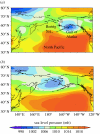Extreme endurance flights by landbirds crossing the Pacific Ocean: ecological corridor rather than barrier?
- PMID: 18974033
- PMCID: PMC2664343
- DOI: 10.1098/rspb.2008.1142
Extreme endurance flights by landbirds crossing the Pacific Ocean: ecological corridor rather than barrier?
Abstract
Mountain ranges, deserts, ice fields and oceans generally act as barriers to the movement of land-dependent animals, often profoundly shaping migration routes. We used satellite telemetry to track the southward flights of bar-tailed godwits (Limosa lapponica baueri), shorebirds whose breeding and non-breeding areas are separated by the vast central Pacific Ocean. Seven females with surgically implanted transmitters flew non-stop 8,117-11,680 km (10153+/-1043 s.d.) directly across the Pacific Ocean; two males with external transmitters flew non-stop along the same corridor for 7,008-7,390 km. Flight duration ranged from 6.0 to 9.4 days (7.8+/-1.3 s.d.) for birds with implants and 5.0 to 6.6 days for birds with externally attached transmitters. These extraordinary non-stop flights establish new extremes for avian flight performance, have profound implications for understanding the physiological capabilities of vertebrates and how birds navigate, and challenge current physiological paradigms on topics such as sleep, dehydration and phenotypic flexibility. Predicted changes in climatic systems may affect survival rates if weather conditions at their departure hub or along the migration corridor should change. We propose that this transoceanic route may function as an ecological corridor rather than a barrier, providing a wind-assisted passage relatively free of pathogens and predators.
Figures



References
-
- Alerstam T. Cambridge University Press; Cambridge, UK: 1990. Bird migration.
-
- Alerstam T. Detours in bird migration. J. Theor. Biol. 2001;209:319–331. doi:10.1006/jtbi.2001.2266 - DOI - PubMed
-
- Alerstam T., Hedenström A. The development of bird migration theory. J. Avian Biol. 1998;29:343–369. doi:10.2307/3677155 - DOI
-
- Alerstam T., Lindström Å. Optimal bird migration: the relative importance of time, energy, and safety. In: Gwinner E., editor. Bird migration: physiology and ecophysiology. Springer; Heidelberg, Germany: 1990. pp. 331–351.
-
- Alerstam T., et al. A polar system of intercontinental bird migration. Proc. R. Soc. B. 2007;274:2523–2530. doi:10.1098/rspb.2007.0633 - DOI - PMC - PubMed
Publication types
MeSH terms
LinkOut - more resources
Full Text Sources

